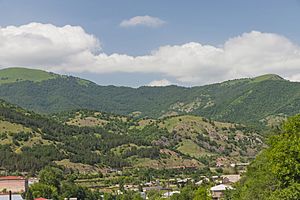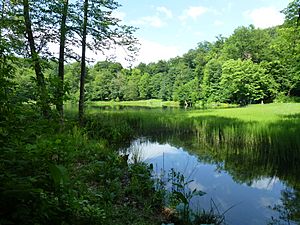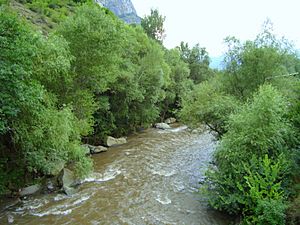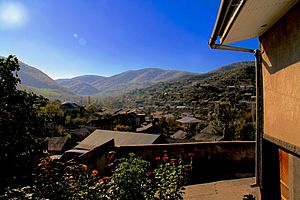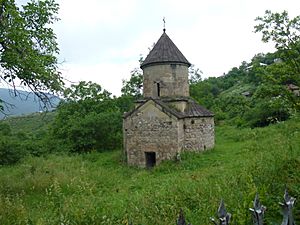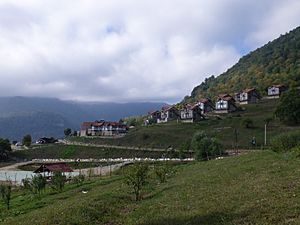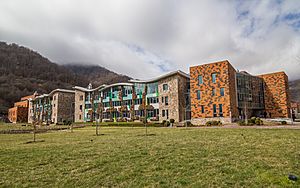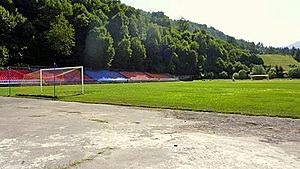Tavush Province facts for kids
Quick facts for kids
Tavush
Տավուշ
|
|
|---|---|
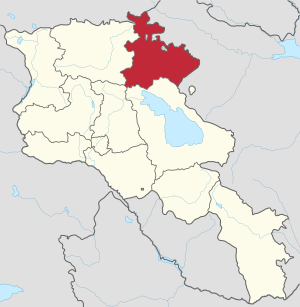 |
|
| Country | Armenia |
| Capital and largest city |
Ijevan |
| Area | |
| • Total | 2,704 km2 (1,044 sq mi) |
| Area rank | 4th |
| Population
(2011)
|
|
| • Total | 128,609 |
| • Estimate
(1 January 2019)
|
122,200 |
| • Rank | 10th |
| • Density | 47.563/km2 (123.186/sq mi) |
| Time zone | UTC+04 |
| Postal code |
3901–4216
|
| ISO 3166 code | AM.TV |
| FIPS 10-4 | AM09 |
| HDI (2017) | 0.732 high · 7th |
| Website | Official website: http://tavush.mtad.am/ |
Tavush (Armenian: Տավուշ) is a province in Armenia. It is located in the northeast part of the country. Tavush borders Georgia to the north and Azerbaijan to the east. Inside Armenia, it borders the Gegharkunik Province to the south, Kotayk Province to the southwest, and the Lori Province to the west. The capital and largest city of the province is Ijevan.
Contents
What's in a Name? The History of Tavush
The name of the province comes from Tavush. This is a different way of saying Tuchkatak, which was an old area. Tuchkatak was part of the historic Utik province in Ancient Armenia. The name Tavush first appeared in the 9th century. It was used for a fortress from that time near the modern town of Berd.
Exploring the Geography of Tavush
Tavush covers an area of 2,704 square kilometers. This is about 9% of Armenia's total land. It is in the northeastern part of the country. To the north, it borders Georgia, and to the east, it borders Azerbaijan. Inside Armenia, it shares borders with Gegharkunik, Kotayk, and Lori provinces.
The land in Tavush is mostly mountainous. It has rocky hillsides covered with green Alpine meadows. Because of its beautiful nature, Tavush is sometimes called a "little Armenian Switzerland." The average height of the region is about 900 meters above sea level.
Mountains and Rivers of Tavush
The province is entirely within the Lesser Caucasus mountains. It is surrounded by the Miapor mountains in the east and the Somkheti mountains in the north. The Gugark mountains are to the east, and the Kenats mountains are to the south. The highest point in Tavush is Miapor peak, which is 2,993 meters tall. The lowest point is 380 meters high, found in the Debed river valley near Debedavan village.
Tavush is an important source of water for Armenia. The main river is the Aghstev river. It has smaller rivers that flow into it, like the Getik, Voskepar, and Sarnajur. Other smaller rivers include Akhum, Tavush, and Khndzorut.
The province also has many mountain springs and mineral water sources. There are small lakes too, such as Lake Parz and Lake Gosh.
Forests and Protected Areas
Most of Tavush is covered with thick forests. These forests are mainly found around the towns of Dilijan, Ijevan, and Berd. The province has several protected forests. These include the Dilijan National Park, Akhnabad Taxus Grove Sanctuary, and Ijevan Sanctuary.
A Look at Tavush's History
The areas that are now Lori and Tavush, along with nearby Georgia, became part of the Russian Empire in the early 1800s. This happened officially in October 1813. It was part of the Treaty of Gulistan, signed after a war between Russia and Persia.
Later, in 1840, the Elizavetpol uezd was created. Most of Tavush was included in this new Russian area. In 1868, the Elisabethpol Governorate was set up. Tavush then became part of its Kazakh uezd district.
From 1930 to 1995, modern Tavush was divided into three districts. These were Ijevan, Noyemberyan, and Shamshadin. In 1995, these three districts were combined. This is how the Tavush Province was formed.
People and Communities in Tavush
Tavush is the second least populated province in Armenia. In 2011, the official count showed Tavush had 128,609 people. This is about 4.3% of Armenia's total population. About 42.1% of the people live in cities, and 57.9% live in rural areas.
The province has 5 cities and 55 rural communities. The largest city is Ijevan, which is also the provincial capital. It has a population of 21,081. Other cities include Dilijan, Berd, Noyemberyan, and Ayrum.
The village of Koghb is the largest rural community in Tavush. It has a population of 4,420 people.
Ethnic Groups and Religion
Most people in Tavush are ethnic Armenians. They belong to the Armenian Apostolic Church. The church's main group in the area is the Diocese of Tavush. Its leader is Bishop Bagrat Galstanyan. The Surp Nerses Cathedral in Ijevan is the main church for the diocese.
The town of Berd is home to about 200 Udis. They also belong to the Armenian Church. A small group of Yazidis lives in Dilijan.
Administrative Divisions
Tavush is divided into 24 local communities. Five of these are urban (cities), and 19 are rural (villages). This structure was created through changes made between 2015 and 2017.
Some rural settlements in Tavush have been left empty in recent years. These include villages like Chermakavan and Gomer.
Culture and Heritage of Tavush
Tavush is rich in history and ancient sites.
Old Fortresses and Sites
- Tavush Fortress: Built in the 10th century.
- Berdavan Fortress: Also from the 10th century.
- Tevrakar castle: Dates back to 5th-7th centuries BC.
- Aghjkaberd Fortress.
- Sranots Bridge: Built between the 13th and 14th centuries.
Ancient Churches and Monasteries
- Tsrviz Chapel: From the 5th century.
- Holy Mother of God Church of Voskepar: From the 7th century.
- Kirants Monastery: Built in the 8th century.
- Makaravank monastery: From the 10th century.
- Jukhtak Vank monastery: From the 11th-12th centuries.
- Goshavank monastery: From the 12th century.
- Aghavnavank Monastery: From the 12th-13th centuries.
- Samsonavank Monastery: From the 12th-13th centuries.
- Shkhmurad Monastery: From the 12th-13th centuries.
- Matosavank monastery: Built in 1247.
- Arakelots Monastery of Kirants: From the 13th century.
- Haghartsin Monastery: From the 13th century.
- Nor Varagavank monastery: From the 13th century.
- Khoranashat Monastery: From the 13th century.
- Srvegh Monastery: From the 13th century.
Local Media
Tavush has three local TV stations:
- "Ijevan TV" is based in Ijevan.
- "Kamut TV" is based in Noyemberyan and started in 1994.
- "Tavush TV" is also based in Noyemberyan and started in 2010.
Economy and Industry in Tavush
Tavush has a smaller economy compared to other Armenian provinces. It contributes about 4.8% to Armenia's total yearly farm products. About 41% of the province's land (1,108 square kilometers) is suitable for farming. Of this, 23% (256 square kilometers) is actually plowed. People in many rural areas mainly work in farming, raising cattle, and pig farming. The main crops grown are grains and grapes.
Recently, many communities have also started bee-keeping farms.
Local Industries
Tavush has the lowest industrial output among Armenian provinces. It makes up only 0.8% of Armenia's total yearly industrial products. The main industries are food processing and making alcoholic drinks.
- Ijevan is the main economic hub of Tavush. During the Soviet era, the town saw a lot of industrial growth. This was especially true for carpet making and wood processing. Many old factories still operate in Ijevan. These include the "Ijevan Woodworking Enterprise" (started 1936) and the "Ijevan Wine-Brandy Factory" (started 1951). This factory is famous for its pomegranate wine. Other factories are the "Ijevan Mechanical Enterprise" (started 1954) and the "Jrashogh Ijevan Carpets" weaving mill (started 1959). The Ijevan carpet mill was the largest in the Caucasus region. The town is also known for its handmade rugs and carpets. After Armenia became independent, many smaller factories opened. One example is the "Karart" stone processing plant (since 2003). In 2014, the "Vector" company, which develops software, opened in Ijevan.
- Other important factories in the province include the "Berdavan Wine Factory" in Berdavan village. There's also the "Maga" food-processing factory in Varagavan and "Vital Echogarden" in Aygedzor. The "Tavush Textile" factory is in Choratan. The "Bavagarm" meat-processing plant is in Teghut. The "Filishin" concrete plant is in Haghartsin.
- Dilijan is known for its mineral water. The "Dilijan Mineral Water Plant" (started 1947) processes and bottles this water. The town also has the "Aramara" company for fine woodworking (started 1993). The "Dili" factory for dairy products opened in 2005.
- The small town of Ayrum has the "Ayrum Cannery" (since 1937) and the "Ayrum Fruits" food-processing factory (since 2014).
Tourism in Tavush
Tourism is growing in Tavush. The region's cultural history and natural beauty attract many visitors.
The town of Dilijan is a major tourist spot for both locals and international visitors. It is also seen as a financial center. This is because much of the Central Bank's work moved to Dilijan in 2013. The town is also famous for its health resorts and mineral water. Other places that attract tourists include the villages of Achajur, Gosh, Teghut, and Yenokavan.
Many forests in the province are protected areas in Armenia. These include the Dilijan National Park and the Ijevan Sanctuary.
Lake Gosh, Lake Parz, and the Ijevan Dendropark are popular places for people who enjoy ecotourism.
Education in Tavush
Tavush has recently become an important place for education in Armenia. In 2014, the United World College Dilijan opened. This school is part of the worldwide United World Colleges educational movement.
Between 2013 and 2015, the Dilijan Central School was built in Dilijan. This school is a branch of the Ayb Educational Foundation. It officially opened in the fall of 2015.
Since 1994, branches of the Yerevan State University have been operating in Ijevan.
As of the 2015-16 school year, Tavush had 81 schools.
Sports in Tavush
Football is a popular sport in Tavush. The province used to have teams in the Armenian Premier League. These were Impulse FC from Dilijan and FC Bentonit Ijevan. However, both clubs had to close because of money problems.
Dilijan City Stadium and Arnar Stadium are the two largest sports venues in the province. Smaller stadiums can also be found in Noyemberyan and the village of Achajur.
Arnar Stadium hosted the final match of the Armenian Independence Cup in 2008. In that game, Ararat Yerevan won against Banants.
Ijevan is also the location for the annual MultiForce off-road racing competition. This international event brings participants from Armenia and nearby countries.
Images for kids
- Tavush
See also
 In Spanish: Provincia de Tavush para niños
In Spanish: Provincia de Tavush para niños
- Eridzor
- Geyarchin
- Golovino
- Kirgi
- Kozman
- Krivoy Most
- Maflar
- Papanino
- Turdzhan
- UWC Dilijan
- Ijevan Wine-Brandy Factory
- Dilijan National Park
- Ijevan Dendropark


